Health and vitality are foundational for thriving individuals, families, and communities – they help foster a healthy economy, workforce, and society. As a forward-looking global health services provider, Cigna HealthcareSM has commissioned the International Health Study to track the changes in health and vitality levels in 11 markets globally. Our aim is to provide insights into the key aspects of people’s health and well-being in order to improve the vitality of those we serve.
Vitality is an individual’s ability to pursue life with health, strength, and energy. We believe this is essential for individuals, but also a catalyst for business and community growth. By tracking the vitality of people across the world, our aim is to help people understand the characteristics of a healthy society.
Our 2024 research looks at the full picture of people’s health and well-being, going beyond physical and emotional health. As such, this report draws attention to the continuing challenge of financial stress and the importance of people’s experience at work.

Chapter 1: Health and Vitality in the global population
We designed the Evernorth Vitality Index (EVI) to help generate insights about health and well-being globally. The EVI gives a full picture of health and well-being – composed of multiple, interdependent, dynamic dimensions. It accounts for how people feel about their autonomy, competence, and relatedness across eight dimensions of health: financial, physical, emotional, social, intellectual, environmental, spiritual/purpose, and occupational. The index presents the data as a single, comprehensive score of whole-person health.
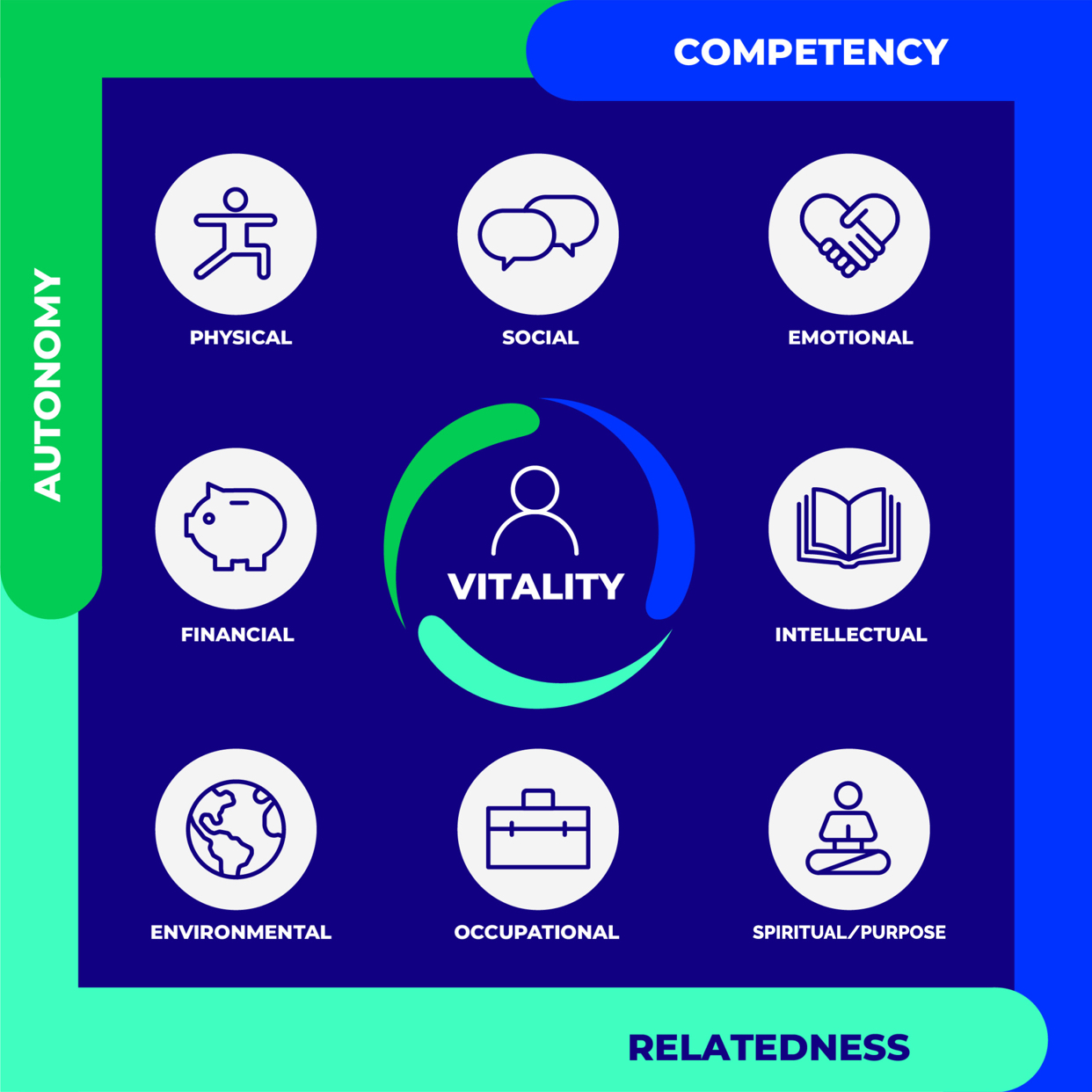
In 2024, 16% of the global population has what we describe as high vitality. These people report more autonomy and competence across all health dimensions, and also rate their overall health higher than other respondents (including physical and emotional wellbeing), underscoring the multi-dimensional character of health.
Our research also reveals important differences between key demographic groups. Men have higher vitality than women. At a generational level, baby boomers (aged 60 and above) display the highest level of vitality, followed by millennials (25 to 44) and Gen Z (18 to 24), with Gen X (45 to 59) reporting the lowest vitality. Unsurprisingly, employed individuals generally have higher vitality than those who are currently not employed.
Global average vitality score
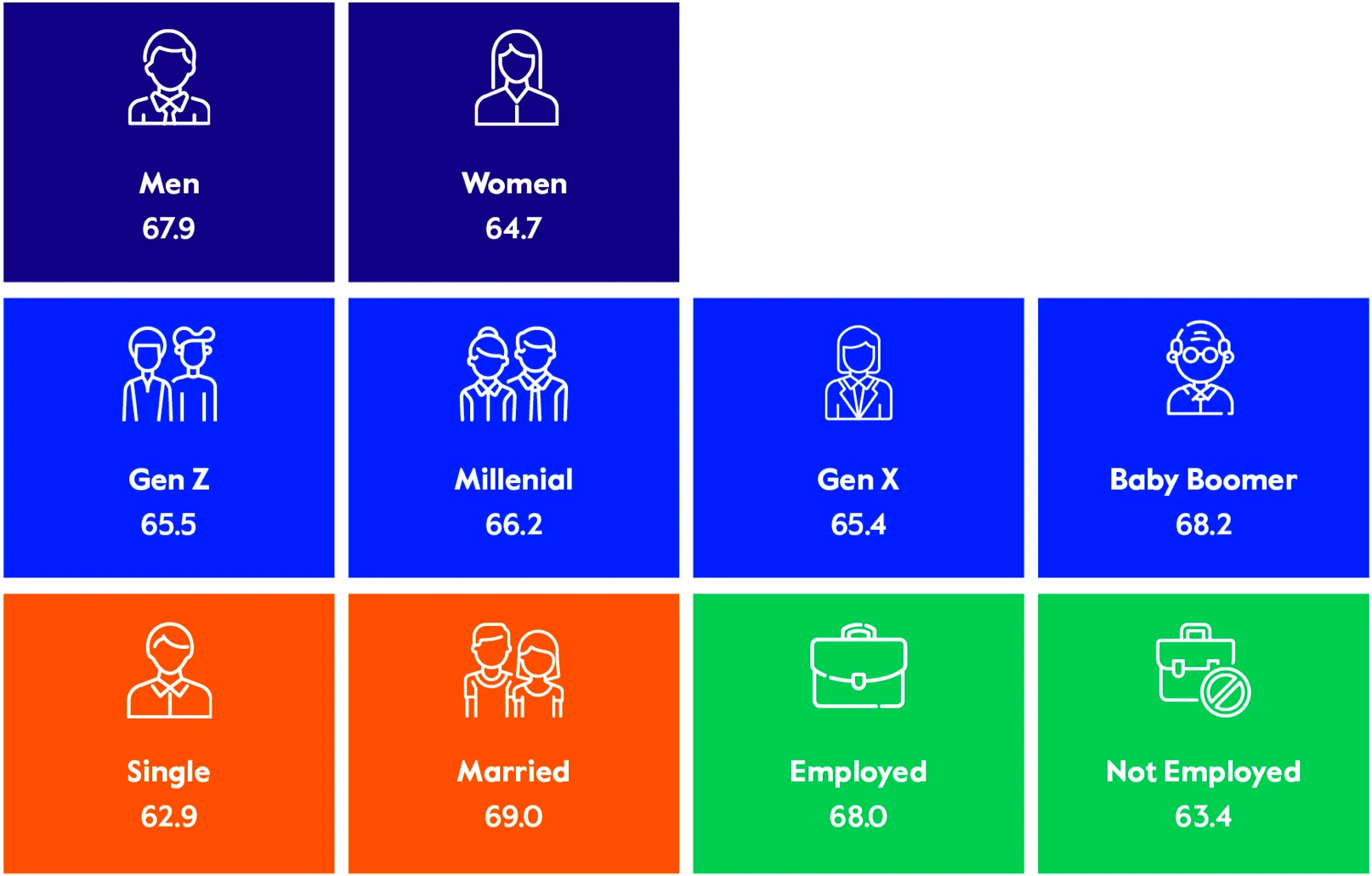
Assessing the elements of vitality beyond physical and mental well-being
How people live and work shapes their lives and health outcomes. By studying differences across vitality groups and key health outcomes, the EVI provides a method to assess health in its fullest sense.
For example, the importance of social and physical well-being become apparent when we compare how respondents with different vitality levels rate their autonomy and competence in these areas. 94% of high vitality respondents say they have the skills and tools necessary to live a healthy life (physical vitality), compared to 3% of the low vitality group. At the same time, 93% of high vitality respondents say they can successfully build connections with others (social vitality), as opposed to 4% of those with low vitality.
How high and low vitality individuals rate various vitality dimensions
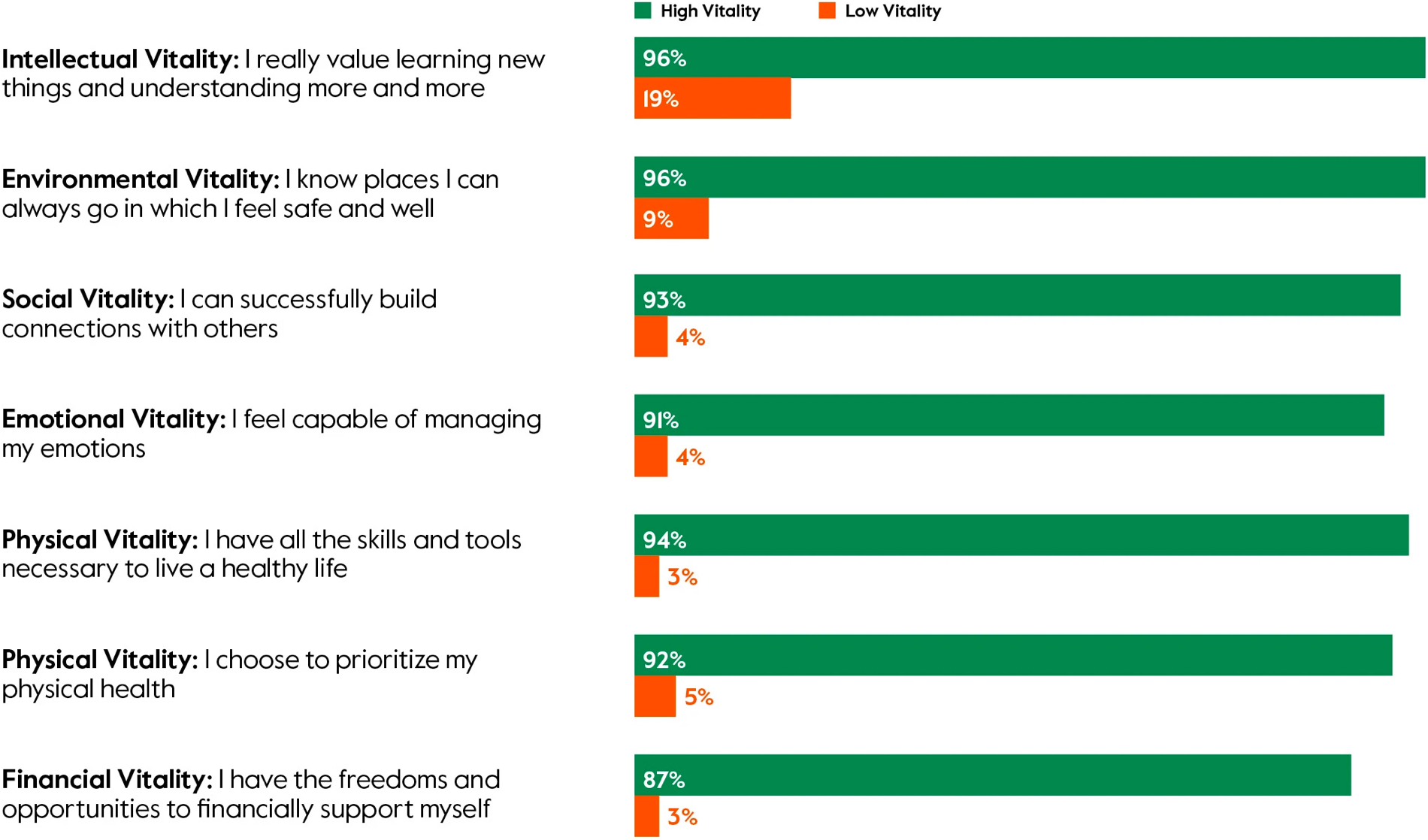
When we look at health outcomes, our research shows that high vitality respondents report better health, lower prevalence of chronic conditions, less stress, and a lower sense of loneliness.
Stress levels across the world
Stress levels have come down in the last year across all demographic groups and markets, with the most significant falls in Hong Kong, the Netherlands and Spain. This fall appears to correlate with the lower levels of stress associated with the cost of living. In Hong Kong, this dropped from 34% in 2023 to 21% in 2024; Netherlands, from 38% to 25%; and in Spain, from 46% to 37%.
Decrease in stress levels across all markets
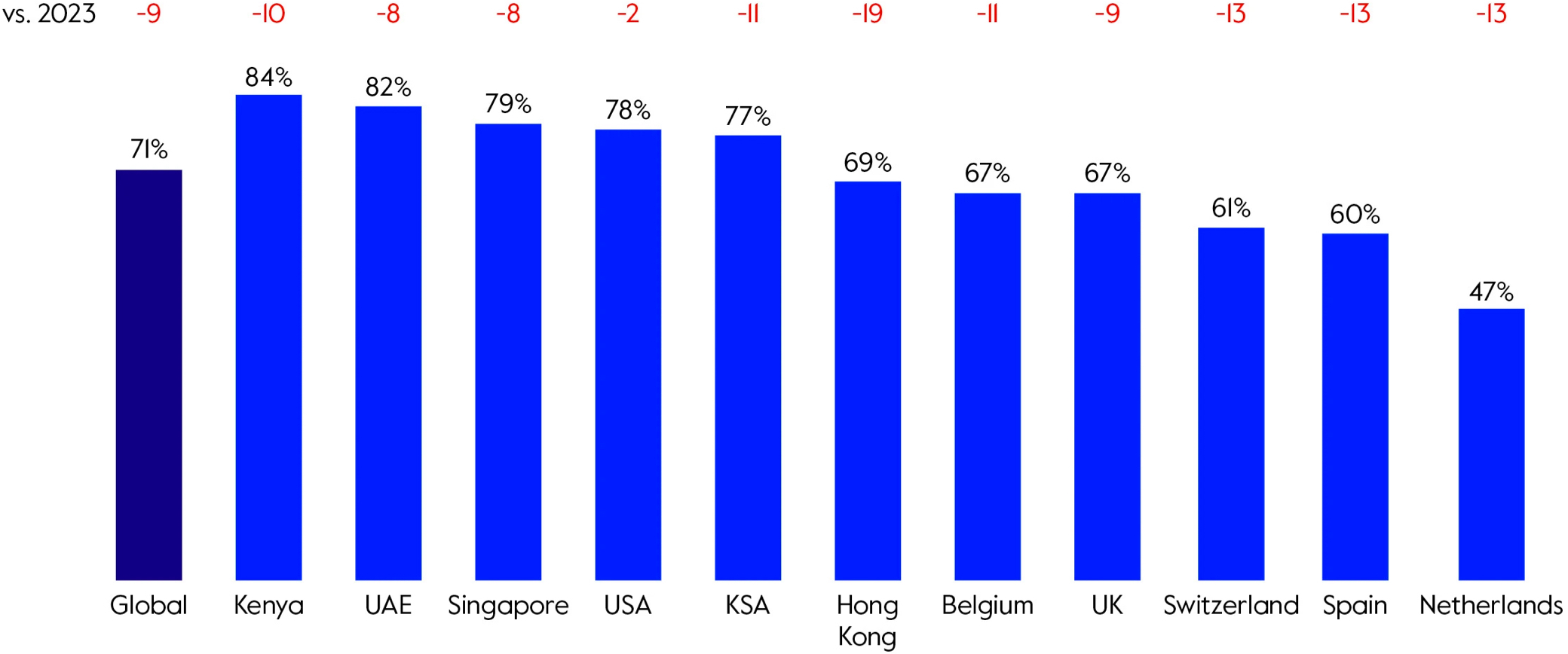
However, cost-of-living remains the primary cause of stress in most regions, with personal finance following closely behind. Uncertainty about the future is a close third globally, although in Spain, the Netherlands, and Hong Kong it has become people’s chief concern.
Higher vitality is linked to better sleep quality and lower stress levels
Our research found that the most frequently reported effect of stress was disrupted sleep. Half of all respondents (50%) said their sleep has been disrupted, representing a 6% rise compared to 2021 (44%). High sleep quality is associated with better overall health, and we found that 82% of those with excellent sleep quality rate their own health as excellent or very good, compared to 14% of those with poor sleep quality.
We also see a correlation with vitality scores. Only 36% of high vitality individuals say that disrupted sleep is a major effect of stress, compared to 64% of those with low vitality.
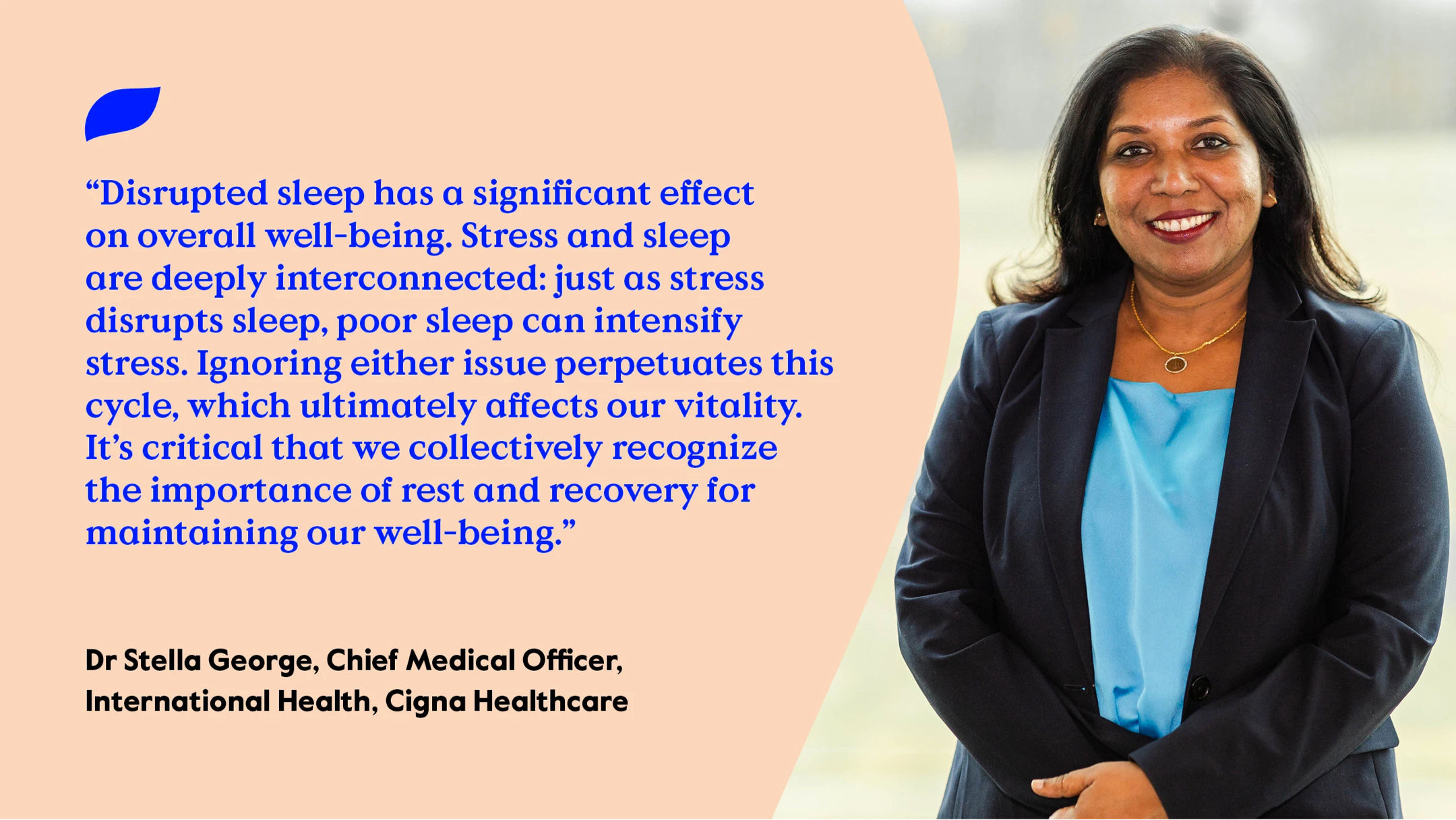
Interpersonal relationships and social connectivity fuel vitality
Relationships significantly shape our sense of purpose, belonging, and vitality. People who are married or partnered are more likely to experience higher levels of vitality compared to people who identify as single, with the average married person having a vitality score of 69.0, compared to 62.9 for single people.
Social relationships are also a driver of high vitality and, encouragingly, social well-being has improved significantly over recent years. In 2022 only 36% of respondents reported excellent or very good social well-being, whereas in 2024 this has risen to 45%.
Improvement in social well-being

Chapter 2: Diminished vitality on stark display in the workplace
Work is central to most people’s lives. Hence, we see that people who are employed score higher across all vitality dimensions than those who are not (68.0 vs 63.4 in 2024). At a market level, we see the highest levels of work well-being in the UAE, KSA, and Hong Kong.
Although employed individuals tend to have higher vitality, there are other factors beside their work which contribute to this. Countries like the KSA and Kenya, which report high levels of work well-being and overall well-being, also show indications that family, physical, and financial well-being are equally important. On the other hand, in European countries like Belgium and the Netherlands, work well-being is relatively low, which correlates with their lower overall well-being figures.
Among the various vitality dimensions, workers and non-workers differ the most in financial vitality, with 40% of workers feeling confident in their ability to financially support themselves, compared to 31% of non-workers. In addition, workers are slightly more likely to feel they have the skills and tools necessary to live a healthy life (40% vs 36%) and see more value in learning new things (55% vs 50%). Workers are also more likely to feel they can connect with others and reported feeling more energized, alive, and vital compared to non-workers.
For those out of work, we see an impact across almost all aspects of health, the largest being physical health, where there is a 16 point difference between employed and non-employed people. This is likely because employment offers many people advantages such as access to healthcare, structured routines, and programs that support maintaining physical health.
How people show up at work is connected with vitality
Vitality is the strength, health, and energy people bring to life and work. Among the working population, high vitality and well-being is linked to higher job satisfaction and to better job performance. Workers with high vitality are more willing to work harder to help their workplace succeed and are more enthusiastic about their job. On the other hand, low vitality in the workplace is connected to lower engagement and productivity. Employees with low vitality are more prone to experience stress at work and are less motivated to contribute to the success of their organization.
Employers need to understand the correlation between work and vitality, and to recognize the importance of keeping people well and healthy, both within and outside the workplace. Health and well-being benefits, culture, policies, and processes are all important parts of the equation.
Flexible work arrangements lift organizational well-being
As workforces globally continue to adapt to changing ways of work, it is important to note that autonomy, competence, and relatedness are foundational for both well-being and job satisfaction. For example, flexible arrangements can contribute to better morale and satisfaction. Hybrid workers are more likely to be satisfied with their job than those working fully in-person (59% vs 55%) and are less likely to search for a new job (36% vs 40%). However, preferences vary by region, with most employees in Spain and Hong Kong favoring in-office work, while those in the Netherlands, Switzerland, the UK, Singapore, and Kenya show a stronger preference for fully remote set-ups.
This could be due to a greater perceived work/life balance and employer support for health and well-being. Compared to employees who work fully in-person, hybrid workers are significantly more likely to feel that their work environment is supportive of their family and personal commitments (56% vs 45%), their employer shows a focus on health and well-being (47% vs 36%), and their employer provides adequate opportunities for them to take care of their personal health (47% vs 40%).
Choice about working arrangements also appears to motivate work efforts and can lead to better business outcomes. Our study shows that hybrid workers are significantly more willing to work harder to help the workplace succeed (70% vs 66%) and enthusiastic about their job (70% vs 64%).
Workplace perceptions by hybrid and fully in-person workers
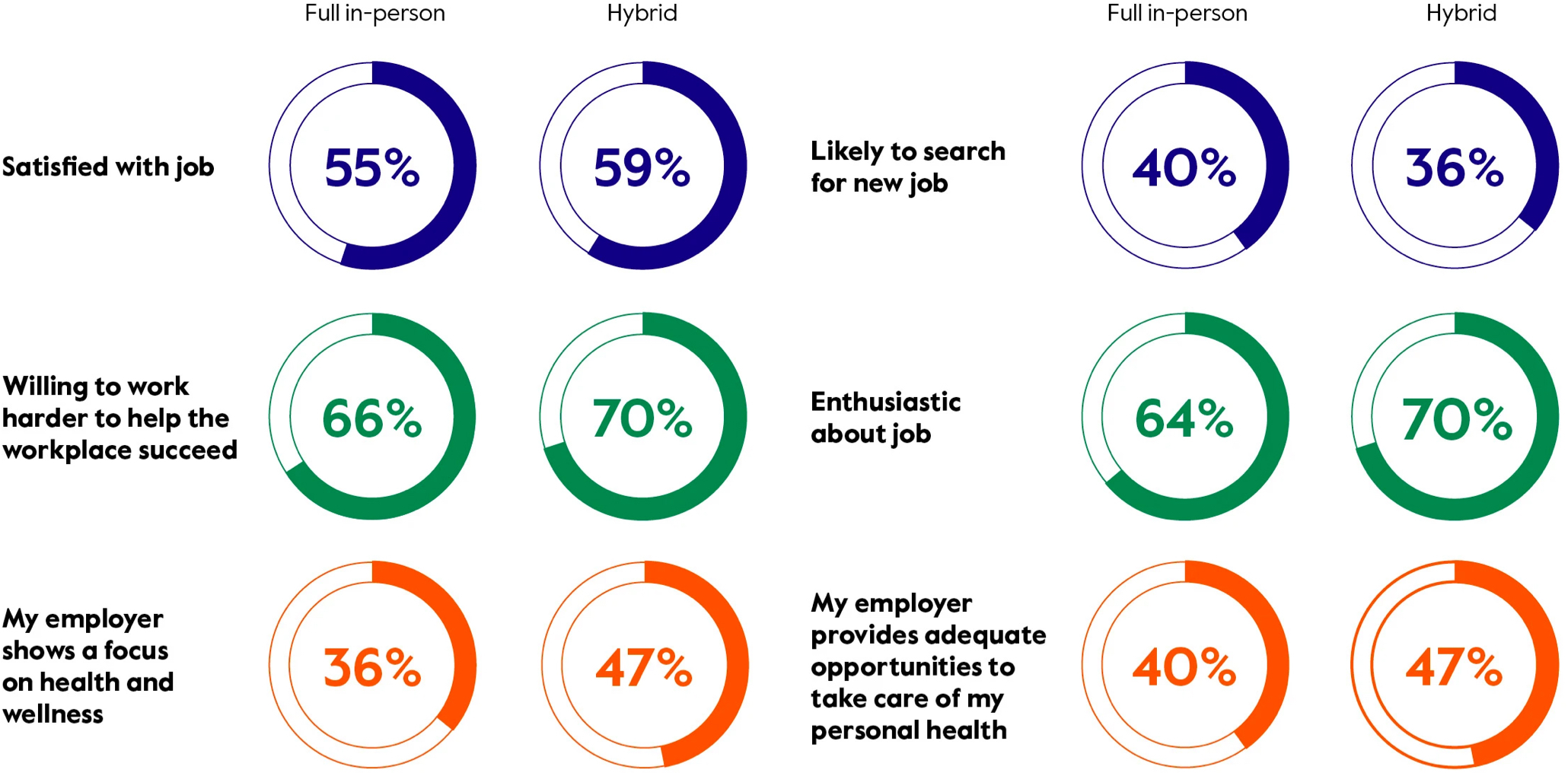
Chapter 3: High vitality individuals are more empowered to manage their health
Individuals with high vitality feel more capable of bouncing back from illness or injury than those with low vitality (88% vs 27%). On the other hand, those with low vitality are more likely to defer medical services, a behavior often driven by limited financial resources.
Financial constraints may push individuals, particularly those with lower vitality, to delay or avoid medical services to avoid incurring costs. This is evident in regions like the Middle East and Africa (MEA) and the United States, where the high cost of healthcare leads many to delay or avoid treatment.
Certain demographic groups are especially impacted by the cost of medical treatment. Women and younger adults, who also face higher stress levels more frequently, are particularly vulnerable. For example, 17% of women report delaying counselling or therapy services versus 12% for their male counterparts. Additionally, while 19% of people overall did not receive necessary medical care due to cost, this figure increases to 23% among adults aged 25-44. Understanding why these groups are more affected by cost barriers can help in tailoring support and interventions to improve their access to essential healthcare services.
Medical services denied due to cost

Chapter 4: Vitality is attainable by all, even those managing chronic conditions
Chronic conditions are a significant global health challenge, affecting millions of people across the world. According to the World Health Organization (WHO), non-communicable diseases such as heart disease, diabetes, and respiratory conditions account for 71% of all deaths globally. This prevalence underscores the urgent need for effective management strategies and robust support systems. The widespread impact of these conditions highlights the importance of addressing them with a comprehensive approach to improve quality of life and health outcomes worldwide.
Our research also shows a connection between vitality and the prevalence of chronic conditions, with 70% of those with low vitality reporting at least one chronic condition, compared to 43% of those with high vitality. Individuals with low vitality are more frequently diagnosed with chronic conditions and also tend to have multiple conditions.
Some 1.7 billion people (22% of the global population) have at least one comorbidity. Such widespread prevalence, particularly amid a rapidly aging global population, requires equally broad awareness, prevention measures, and education about diagnosing and living with chronic health issues.
High vitality is linked to better chronic condition management and active support systems
Those with high vitality are more optimistic about managing their health conditions. 90% of high vitality individuals feel confident in their ability to manage their health, compared to just 19% of those with low vitality. They also report more social support and better physical health. This suggests that high vitality may serve as a buffer or mitigator against the negative effects of chronic conditions.
A crucial factor influencing vitality is the presence of a robust support system. High vitality individuals are significantly more likely to feel they have access to emotional support, quality medical care, and trustworthy assistance when needed. This strong support network contributes to their better management of health conditions and overall resilience.
In contrast, individuals with low vitality often report less access to these support systems, which exacerbates their health challenges. This disparity in confidence levels between high and low vitality individuals in managing health conditions highlights the need to educate and empower patients.
Case study: Spotlight on musculoskeletal (MSK) health
MSK conditions affect over 1.7 billion people globally and are the leading cause of disability in many countries. Our research shows that among those suffering from MSK conditions, 42% also report having a mental, behavioral, or emotional health condition. These findings highlight the comorbidities faced by many individuals with MSK conditions and underscore the need for targeted efforts to enhance vitality and provide robust support systems for those affected.
The link between low vitality and chronic conditions underscores the need for comprehensive health management strategies that enhance vitality. Improving access to emotional support, quality medical care, and reliable assistance can empower individuals to manage their MSK conditions more effectively, reducing reliance on medication and improving overall health outcomes. A comprehensive approach, including lifestyle changes and self-management education, offers a sustainable way to manage these conditions.
Conclusion
Our survey reveals a clear picture of widespread, interrelated well-being challenges and an urgent need for whole-person health solutions. To support their people effectively, employers should broaden their focus beyond physical and mental considerations alone, recognizing there are multiple pathways to achieve overall vitality.
Only by addressing the multiple determinants of health – such as social, financial, and intellectual well-being – can organizations effect real change in people’s lives. For example, the financial stress that so many respondents have been experiencing can be greatly mitigated with the right resources in related areas, such as reliable health insurance and community support systems.
These efforts are not about handholding: people need broad support in order to overcome their challenges with autonomy and resilience. By adopting far-reaching approaches such as flexible work arrangements, well-being-oriented organizational cultures, and targeted support for vulnerable groups, we can achieve greater health and productivity for everyone.
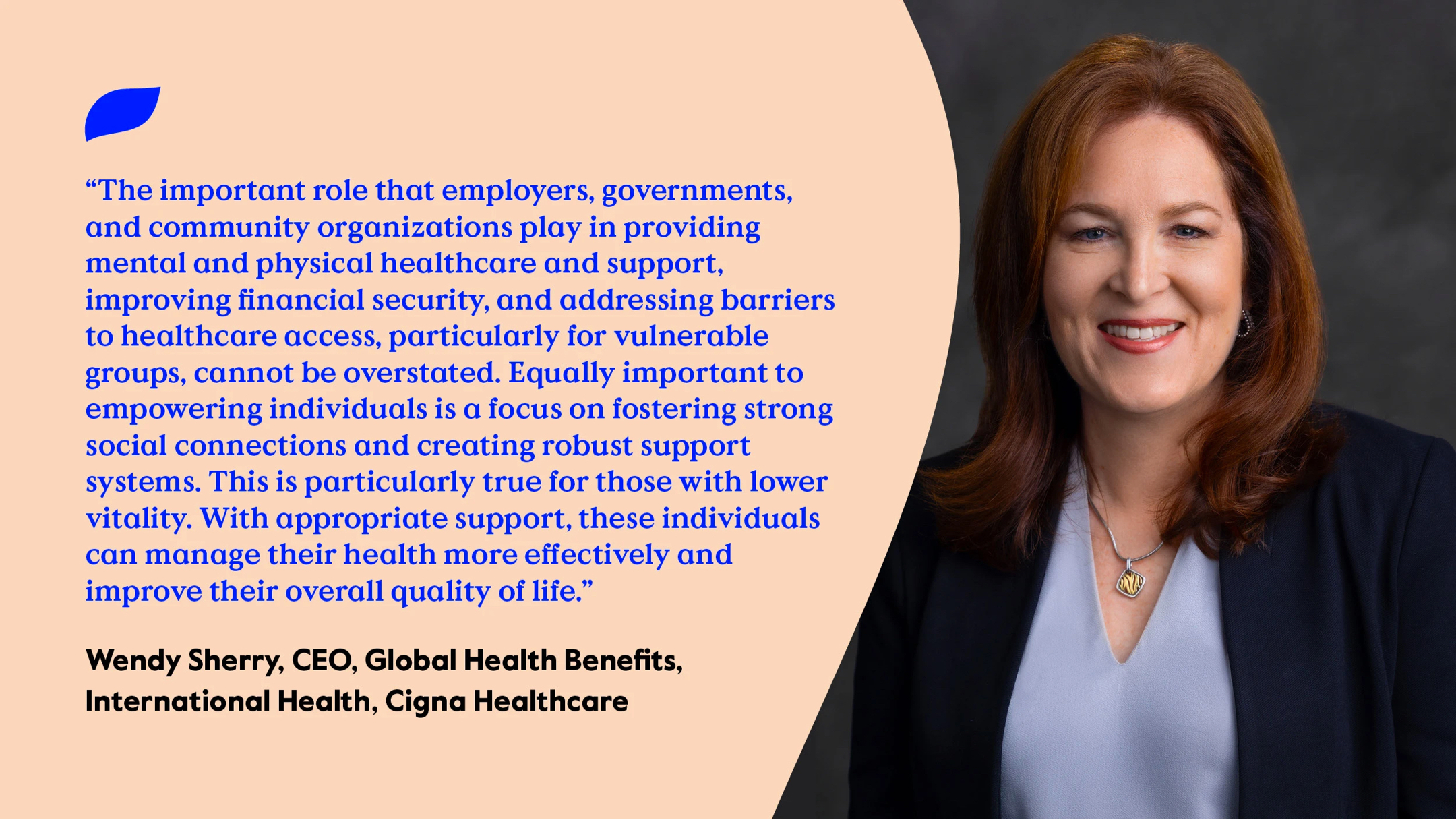
About the research
Cigna Healthcare surveyed more than 10,000 respondents in 11 markets – the US, UK, Spain, Netherlands, Belgium, Switzerland, Kenya, UAE, Saudi Arabia, Singapore, and the Hong Kong SAR from May 9-27, 2024 in collaboration with YouGov – a global public opinion and data company. The nationally representative online survey assessed the health, vitality and well-being of more than 1,000 adults (aged 18 years and older) in each of these markets - US, UK, Spain, UAE, Singapore and the Hong Kong SAR, and more than 500 adults per market in Kenya, Belgium, Netherlands, Saudi Arabia, and Switzerland.
The Evernorth Vitality Index© and Well-Being Index
The Evernorth Vitality Index© (EVI) has been developed in partnership with leading clinical psychologist and author Dr. Richard Ryan. It gives a comprehensive measure of people’s capacity to pursue life with health, strength, and energy. This is closely aligned with our mission to improve the health and vitality of those we serve around the world. We asked a series of questions to gauge respondents’ sense of social, occupational, financial, intellectual, spiritual/purpose, emotional, and environmental well-being.
Respondents were also asked to rate their well-being across seven pillars: family, financial, mental, physical, social, spiritual, work well-being, and overall well-being, with ratings ranging from “poor”, “fair”, and “good” to “very good” and “excellent”.

